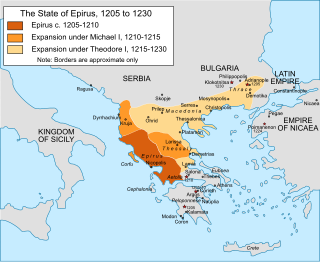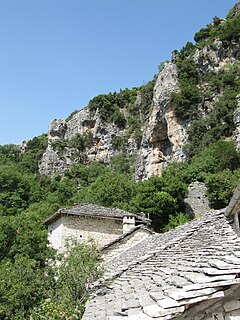 W
WThe Despotate of Epirus was one of the Greek successor states of the Byzantine Empire established in the aftermath of the Fourth Crusade in 1204 by a branch of the Angelos dynasty. It claimed to be the legitimate successor of the Byzantine Empire, along with the Empire of Nicaea and the Empire of Trebizond, its rulers briefly proclaiming themselves as Emperors in 1225/1227–1242. The term "Despotate of Epirus" is, like "Byzantine Empire" itself, a modern historiographic convention and not a name in use at the time.
 W
WAngelokastro is a Byzantine castle on the island of Corfu, Greece. It is located at the top of the highest peak of the island's shoreline in the northwest coast near Palaiokastritsa and built on particularly precipitous and rocky terrain. It stands 1,000 ft (305 m) on a steep cliff above the sea and surveys the City of Corfu and the mountains of mainland Greece to the southeast and a wide area of Corfu toward the northeast and northwest.
 W
WArbanon, or Albanon, was a principality ruled by the native Progoni family, and the first Albanian state to emerge in recorded history.
 W
WThe Chronicle of the Tocco is a chronicle in fifteen-syllable blank verse written in medieval Greek. It covers the period of 1375-1425 and focuses on the ascent of the Tocco family, and especially Carlo I Tocco, Count palatine of Cephalonia and Zakynthos, to the rule over the Despotate of Epirus, as well as Carlo's conquest of territories in the Morea.
 W
WEmpire of Thessalonica is a historiographic term used by some modern scholars to refer to the short-lived Byzantine Greek state centred on the city of Thessalonica between 1224 and 1246 and ruled by the Komnenodoukas dynasty of Epirus. At the time of its establishment, the Empire of Thessalonica, under the capable Theodore Komnenos Doukas, rivaled the Empire of Nicaea and the Second Bulgarian Empire as the strongest state in the region, and aspired to capturing Constantinople, putting an end to the Latin Empire, and restoring the Byzantine Empire that had been extinguished in 1204.
 W
WGardiki Castle is a 13th-century Byzantine castle on the southwestern coast of Corfu and the only surviving medieval fortress on the southern part of the island. It was built by a ruler of the Despotate of Epirus, and was one of three castles which defended the island before the Venetian era (1401–1797). The three castles formed a defensive triangle, with Gardiki guarding the island's south, Kassiopi Castle the northeast and Angelokastro the northwest
 W
WThe Monastery of Saint Paraskevi is an abandoned monastery situated on the edge of Vikos Gorge, in the region of Zagori,, northwestern Greece. The monastery founded at 1413–1414, consists of a small stone-built chapel, the oldest preserved in Zagori, and offers panoramic views to the gorge.
 W
WThe Church of the Parigoritissa or Paregoretissa is the 13th-century Byzantine metropolitan church of the Greek city of Arta. Part of the building used to house the Archaeological Collection of Arta.
 W
WThe Red Church is a Byzantine church from c. 1280 in the village of Vourgareli in the Tzoumerka region of Greece.
 W
WBorsh Castle also known as Sopot Castle from the hill it is located, is a ruined castle near the village Borsh, Albania, near the coast of the Ionian Sea. Inside the castle is the 17th-century Hajji Bendo Mosque from Ottoman times.
 W
WThe family of Tocco was a noble house from Benevento of Longobard origins, which in the late 14th and 15th centuries came to prominence in western Greece as rulers of the Ionian Islands, County palatine of Cephalonia and Zakynthos and the Despotate of Epirus.